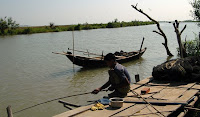Water Woes Still Plague Nargis Survivors
By MINN MINN / IPS WRITER
The Irrawaddy News
“When the water is below us, we can make a living. But when it is above us, we die,” 76-year-old U Toe mused, looking back at the damage dealt by Cyclone Nargis nearly a year ago on May 2, 2008.
At the end of its fury, the cyclone, with sustained winds of close to 200 kilometers per hour, killed at least 137,000 people and destroyed the lives of thousands more. Many of these people depended on the natural resources of the fertile Irrawaddy delta, which was hardest hit by the disaster.
 Those who survived the initial fury of the disaster soon faced—ironically enough—a lack of potable water. Wells and ponds, traditional sources of fresh water, had been inundated by the inflow of seawater. Water containers, which are typically large ceramic jars or clay pots, were smashed in the devastation. Long lines of survivors, carrying whatever containers they had in order to get water, became a familiar sight immediately after recovery efforts began.
Those who survived the initial fury of the disaster soon faced—ironically enough—a lack of potable water. Wells and ponds, traditional sources of fresh water, had been inundated by the inflow of seawater. Water containers, which are typically large ceramic jars or clay pots, were smashed in the devastation. Long lines of survivors, carrying whatever containers they had in order to get water, became a familiar sight immediately after recovery efforts began.In hindsight, the cyclone highlighted in the cruelest fashion the delicate balance between man and water in the delta. The fertile soil, availability of water and ample supply of labor once made this area the rice bowl of the world. The waters of the delta also supported rich fish and shrimp farms as well as natural salt farms.
But over the years, human habitation gradually changed the topography of the delta and weakened the environment’s ability to resist cyclone-induced strong waves and winds. This transformation accelerated over the past two decades, as mangrove forests were cleared for charcoal production and shrimp and fish farming. Dhani (nipa palm) trees were even more intensively felled to provide thatch for the roofs of traditional village homes.
Today, water problems continue to be among the biggest everyday concerns of local residents, although relief and assistance accelerated immediately after the cyclone.
In the months after the disaster, plastic jerry cans were imported for residents’ water needs, and traditional ceramic jars and clay pot water containers were brought in from other parts of Burma.
Ponds have been repeatedly cleaned since then, but survivors claim that seepage of saltwater into groundwater sources has increased and clearing is therefore of little avail. Digging of new wells may therefore not be an option.
Substantial resources have also been expended on fencing off the remaining 40 percent of usable ponds and reservoirs—although there are now few cows or buffaloes left to trespass into them.
Water filters of different types have been distributed by international and local non-government groups and water rationing was enforced in villages at one point, but water problems in the delta will remain for years to come.











